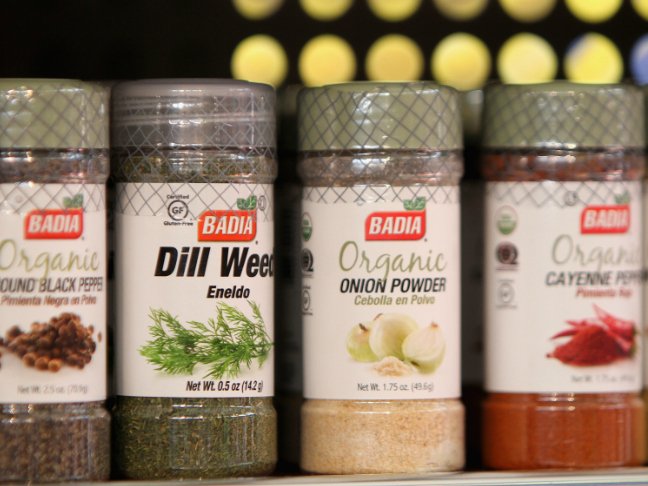IMAGE: Getty
When you make your own baby food, you are able to experiment with different tastes and textures for your baby and best of all, you have the chance to use a wider variety of ingredients than what is found in commercial baby food. Most conventional brands of commercial baby foods do not incorporate herbs and spices into their jars, which is really a shame. Take advantage of the versatility of homemade baby food and use everyday spices and herbs to liven up baby’s foods. This is a wonderful way to help expand your baby’s taste buds and get her used to the tastes of the family’s foods.
Bland Baby Food is not Better!
In many countries, babies are not fed bland rice cereals as their first foods rather, they introduced to spices from the start. In India for example, they think nothing of adding a bit of curry spices to baby’s foods at a very early age. Thai families often incorporate coconut milk, lemongrass, tamarind and even chili when feeding their babies solid foods. Latino babies are exposed to taste of wonderful herbs and spices such as cumin, cilantro and even chili peppers!
When Can I Add Herbs and Spices to Baby’s Food?
A majority of pediatricians will recommend waiting until an infant is 8 months or older to introduce spices and herbs. This recommendation often has more to do with staving off digestive upsets than it does with possible allergic reactions. If your baby is doing well with foods and does not seem to have any digestive upsets, then jump right in with spices! Like any other new food, please follow the “4 day wait rule” when introducing spices and herbs. As always, please discuss the introduction and use of herbs and spices with your baby’s pediatrician.
Don’t forget, if you are a breastfeeding Mom, your little one is already tasting herbs and spices. Herb and spice flavors are transferred through breast milk, helping create and develop a taste for non-bland foods.
What Types of Spices and Herbs Can I Add to Baby’s Food?
Often when we think of adding something to the foods we feed are older kiddos, sugar and/or salt may be the first items to come to mind. Why is that we as parents may seldom think about adding herbs and spices to our kids food and to our baby’s food?
Fresh or dried, the types of herbs and spices you may add to baby’s foods is entirely up to you. I would recommend that you use all the spices and herbs that are typically used when cooking foods for the “big kids”. Using spices and herbs in your baby’s foods is a great way to offer interesting flavors without the use of sugar or salt. While it is never recommended to add sugar or salt to baby’s food, we always advocate adding some things to “spice up” or flavor your baby’s food. Here are a few great herbs and spices to try:
- vanilla *
- pepper
- garlic – minced or powdered
- basil
- rosemary
- dill
- oregano
- lemon zest
- ginger
- cinnamon
- mint
- nutmeg
- anise
- curry powder (yes, you may offer your older infant a dash of curry powder in her foods. You do need to watch for any reactions as some components of curry or even chili powder may give baby a rash)
The spices noted above can be lovely additions to your baby’s foods. If your family meals include a lot of herbs and spices then Introducing baby to spices that the family typically cooks with is important. Adding these flavorful extras does not have to wait until your little one has reached toddlerhood. BONUS! Introduction of spices early and often may one day find you thinking, “Wow, we have never used salt or sugar in any or our kid(s)’ foods!”. Imagine raising a child that is not reliant on artificial sweeteners to entice the appetite and please the tastebuds.
Spiced Up Baby Food Creations – a few examples
Try these spicy mixtures and put some baby zing into those everyday foods for baby:
Fruits:
Apple(Sauce): use cinnamon, nutmeg, allspice, vanilla, ginger
Pears: use ginger, cinnamon, a drip of vanilla or even mint
Bananas: use cinnamon, ginger, allspice, vanilla
Dairy:
Plain Yogurt : use with mint, cinnamon, nutmeg, vanilla, ginger, allspice, cardamom
Vegetables:
Sweet potato: use with nutmeg, cinnamon and/or cardamom
Pumpkin: use with cinnamon, nutmeg, ginger and dash of vanilla
Carrots: use with basil & garlic – baked cinnamon carrots are yummy too.
Green beans: use with garlic powder
Mashed potatoes(white) : use with dill weed or garlic
Winter Squash (acorn, hubbard, butternut etc.): use with cinnamon, nutmeg, allspice, ginger
Cereals/Grains:
Pasta: use oregano, garlic, basil
Oatmeal or other cereals: use fruits, cinnamon & nutmeg, dash of vanilla
Rice (sweet) with cinnamon, nutmeg, dash of vanilla, cardamom, ginger
Quinoa (sweet): use cinnamon, nutmeg, dash of vanilla, cardamom, ginger for sweet
Quinoa (savory): use garlic powder, pepper, onion powder, basil, oregano and others
Meats:
Chicken/Turkey:
- with cinnamon and/or coriander
- with garlic powder and basil
- with lemon zest and pepper
- with basil & oregano
- with garlic and pepper
- with sage, rosemary and thyme
- with cinnamon and/or corain
Beef:
- with garlic and pepper
- with onion powder and pepper
- with plain orange zest
Try Mixing Your Own Spice Blends
Poultry Seasoning Blend
Use this seasoning blend to flavor chicken, turkey, duck, or Cornish game hens. It also makes a great addition to any kind of stuffing that you serve along with your poultry dishes. If you don’t have access to fresh herbs you may substitute 1 teaspoon of the dried herb for 1 tablespoon of fresh.
Ingredients:
- 1 teaspoon celery seeds
- 1 tablespoon fresh marjoram – minced
- 1 tablespoon fresh sage – minced
- 1 tablespoon fresh thyme leaves
Sweet Spice Blend
This recipe makes approximately 3 tablespoons of sweet spice blend. This blend is perfect to use throughout the holidays in all your apple and pumpkin pie recipes. This blend also tastes terrific sprinkled on top of eggnog.
Ingredients:
- 2 teaspoons ground cinnamon
- 1 teaspoon ground cloves
- 1 teaspoon ground ginger
- 1 teaspoon ground nutmeg
- 1 teaspoon ground allspice
 Seeds of Knowledge – “Sweet Spices”
Seeds of Knowledge – “Sweet Spices”
* A note concerning vanilla and other liquid flavor extracts
Pure vanilla and other liquid flavors/extracts, depending on the market/country where you may live, often contain a high amount of alcohol. The alcohol is used to extract and preserve the flavor of the spice.
When using vanilla as a flavoring for your baby food, ensure that you are using either the vanilla bean or an essence of vanilla that is not labeled as “pure”.
You may use pure vanilla for adding to foods that are cooking or baking as the alcohol will cook off. Never add any sort of flavoring to your baby’s bottle of formula or bottle of breast milk.
![]() Remember, always consult with your pediatrician regarding introducing solid foods to your baby and specifically discuss any foods that may pose allergy risks for your baby.
Remember, always consult with your pediatrician regarding introducing solid foods to your baby and specifically discuss any foods that may pose allergy risks for your baby.
![]() This site complies with the HONcode standard for trustworthy health information: verify here.
This site complies with the HONcode standard for trustworthy health information: verify here.

